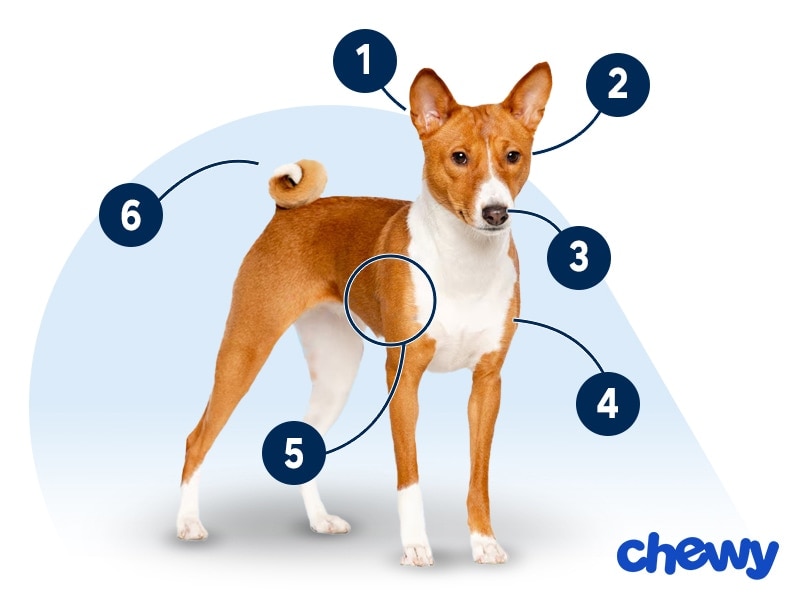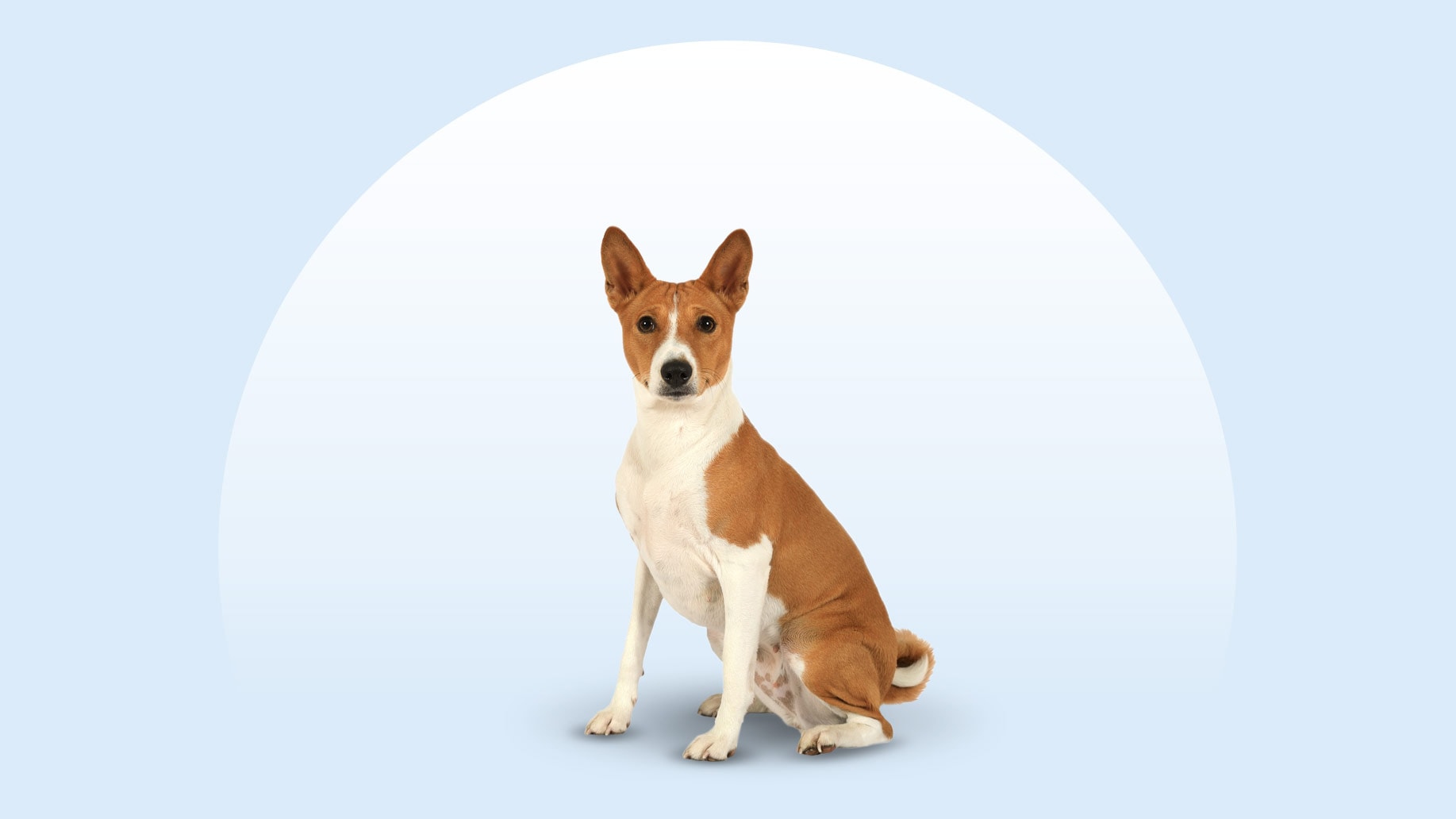Basenji
Updated September 23, 2025
Basenji
Updated September 23, 2025
The Basenji is a spirited, unique dog often compared to a cat because they tend to be aloof and exceptionally clean. These clever pups will enjoy lots of physical and mental exercises that challenge their bright mind, and they need a pet parent willing to be their biggest fan.
Aloof, Clever, Energetic
22–24 pounds
16–17 inches
13–14 years
Black and White, Black Tan and White, Brindle and White, Red and White
In the running for Most Unique Dog Out There, the Basenji is likely to take the crown. Just don’t be surprised if instead of a celebratory bark, they offer a yodel.
Yes, the Basenji dog breed has the singsong voice of a Swiss mountaineer, even though they hail from the plateaus of Africa. It doesn’t make a lot of sense, but neither do some of the other best things in life.
Just appreciate this clever, independent pup for the unique individual they are—and be prepared for lots of strangers stopping to ask who this elegant creature is.
Basenji Characteristics
Basenji Appearance
Known for their famous Basenji yodel, the Basenji is a small dog with distinctive, adorable forehead wrinkles. Their body is shorter than they are tall, making them a cute and compact dog who’s elegant, alert, and ready for adventure.

- Ears
The Basenji’s ears are upright and curve in slightly on both sides.
- Eyes
A Basenji’s almond-shaped eyes can range from hazel to dark brown with dark rims.
- Nose
Their nose is usually black.
- Coat Length
Basenji coats are short and smooth.
- Coat Color
Basenji colors include black and white, red and white, tricolor (black, tan, and white), and white and brindle (subtle tiger stripes). The white color is usually more of an accent to the overall base color.
- Tail
Their tail is upright and tightly curled over either side of their back.
Basenji Temperament
If you’re used to Golden Retrievers or Labs, the Basenji might seem like a very odd member of the canine species. They have the elegance of a feline, and they just happen to … yodel?
Basenji dogs are definitely unique, making their pet parent very lucky—and probably popular, as you’re likely to be stopped and asked what breed your pup is.
Basenjis are energetic dogs who are bright and alert. They love to chase things, and they need not only physical but also mental exercise to keep from being bored. Though incredibly smart dogs, they’re also a little aloof sometimes, a quality that also lends itself to their cat-like comparison.
They tend to choose one person to be their very favorite, so if you’re an active pet parent looking for someone who’s faithful—and who you can love back just as much as you love them—the Basenji dog breed might be perfect for you.
How to Care for a Basenji
Basenjis are easy to groom, as they’re fairly clean pups. They’ll need consistent training and a lot of exercise.
Grooming
Training
Diet
Exercise
Environment
Basenji Health
The typical Basenji lifespan is 13–14 years. Here are some health issues to be aware of.
- Fanconi syndrome: Basenjis are predisposed to a genetic condition called Fanconi syndrome, which affects the kidneys and can lead to renal failure if untreated. It’s usually managed with a special diet and mineral supplements, and it may require hospitalization.
- Hip dysplasia: Hip dysplasia is when the ball and socket of the hip and thigh bones doesn’t properly fit. It’s an inherited condition that can be made worse if a dog is overweight. It eventually leads to arthritis and pain. More severe cases may require surgery, but the condition is often treated with medications, joint supplements, special diets, weight management, and/or physical therapy.
- Hypothyroidism: Hypothyroidism includes symptoms like lethargy, hair loss, skin and ear infections, and weight gain. A blood test can diagnose it, and treatment is a daily oral medication.
- Persistent pupillary membrane: This is an eye condition that occurs when the puppy’s fetal tissue remains on the eye after birth. It can cause mild to severe vision issues, but it also sometimes clears up on its own. Either way, persistent pupillary membrane requires a vet’s attention.
- Progressive retinal atrophy (PRA): PRA in dogs leads to blindness. While there is no cure, pups who lose their eyesight tend to adapt well and can still live full, happy lives.
Basenji History
While Basenjis have only been in the U.S. since the 1930s, their history stretches back for centuries. Canine research has shown Basenjis to be a truly ancient dog breed with unique DNA unlike any other domesticated dog breed.
Cave paintings in Africa even depict Basenji-like dogs with curled tails, and these dogs were given to pharaohs in ancient Egypt, according to the Basenji Club of America.
Basenjis were hunting dogs in Africa in the 1800s, and while they fascinated visiting Europeans, early efforts to import them to England proved difficult. The first Basenjis arrived in the U.S. in 1937, and the American Kennel Club recognized the breed in 1944.
Basenji puppies tend to cost between $1,500–$3,000. If you choose this route, pick a responsible breeder.
You can also seek out Basenji dogs for adoption. Look for a local Basenji rescue, like Basenji Rescue and Transport; keep an eye out at your nearby animal shelter; or search Chewy’s database of adoptable dogs in your area.








